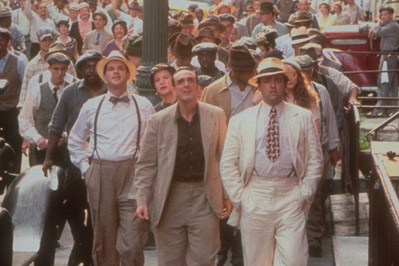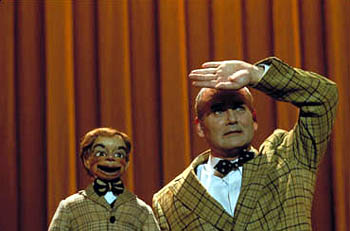

Actual events inspired the movie Cradle Will Rock, which seems part Ragtime, part Illuminata, and part Shakespeare in Love. The Cradle Will Rock is an actual musical from the 1930s, written by Marc Blitzstein. The movie is about the formation of the pro-union musical, and the attempts to shut it down. There are a number of real historical figures portrayed in the film, including William Randolph Hearst, Nelson Rockerfeller, Orson Welles, Diego Rivera, Frieda Kahlo, and lesser knowns like Hazel Huffman, Hallie Flanagan and others that all interact with the fictional characters in the movie. Although the characters are not too compelling, the movie is, for the most, enjoyable.
Blitzstein (Hank Azaria, Mystery, Alaska, Tuesdays With Morrie) is trying to compose a new musical, and is not having much luck. He seems haunted by the ghost of his wife, who is there to criticize his feeble attempts. While watching policemen break up a march in a park, the formative ideas for what will become The Cradle Will Rock take seed. To him, it is a matter of prostituting oneself, whether it is to money, the government, or even art. Eventually, the Federal Theater agrees to produce the show. John Houseman (Cary Elwes, Kiss the Girls, Liar, Liar) and Welles (Angus MacFadden, Titus, The Rat Pack) are on hand to help make the show a reality. Olive Stanton (Emily Watson, Angela's Ashes, Hillary and Jackie) is a homeless woman who gets a job as a stagehand. In reality, she wants to sing in the musical.
Meanwhile, Rockerfeller (John Cusack, Being John Malkovich, The Thin Red Line), with the help of Margherita Sarfatti (Susan Sarandon, Illuminata, Anywhere But Here) commissions Rivera (Ruben Blades, Chinese Box, The Devil's Own) to paint a mural in Rockerfeller Center, and Tommy Crickshaw (Bill Murray, Rushmore, The Man Who Knew Too Little) is a depressed ventriloquist who begins to fall for Huffman (Joan Cusack, Arlington Road, Toy Story 2), a vehement anticommunist. Much of the tension in the movie stems from the prevalent anticommunist feelings at the time. The musical is so controversial because it seems to support unionization, which would in turn, support communism. Rockerfeller is incensed that Rivera decided to include a portrait of Lenin and syphilis within the mural, and Congress is holding McCarthy-like hearings, trying to weed out communists in the theater. Some of the dialogue from the film is lifted from these congressional transcripts.
The most interesting storylines center on Crickshaw and Huffman, the two most human characters. This is also the story that gets the least amount of time. Huffman is the polar opposite of many of the other characters, an interesting study in contrast which is not explored. Both Cusack and Murray, known for their comedic talent, perform well in these more serious roles. Good performances are also given by Vanessa Redgrave (Girl, Interrupted), Watson, and Azaria. Notably sub-par is John Turturro (The Big Lebowski, Illuminata), essentially reprising the same role as in the latter film. The class warfare arguments, especially between Rockerfeller and Rivera seem forced. As for the play itself, the best moment in the movie is when the play finally premieres. It is a moment that is completely expected, yet it retains the triumph that writer/director Tim Robbins (Arlington Road, Nothing to Lose) intended. The same cannot be said about the rest of the movie, which wavers between good and not-too-interesting.